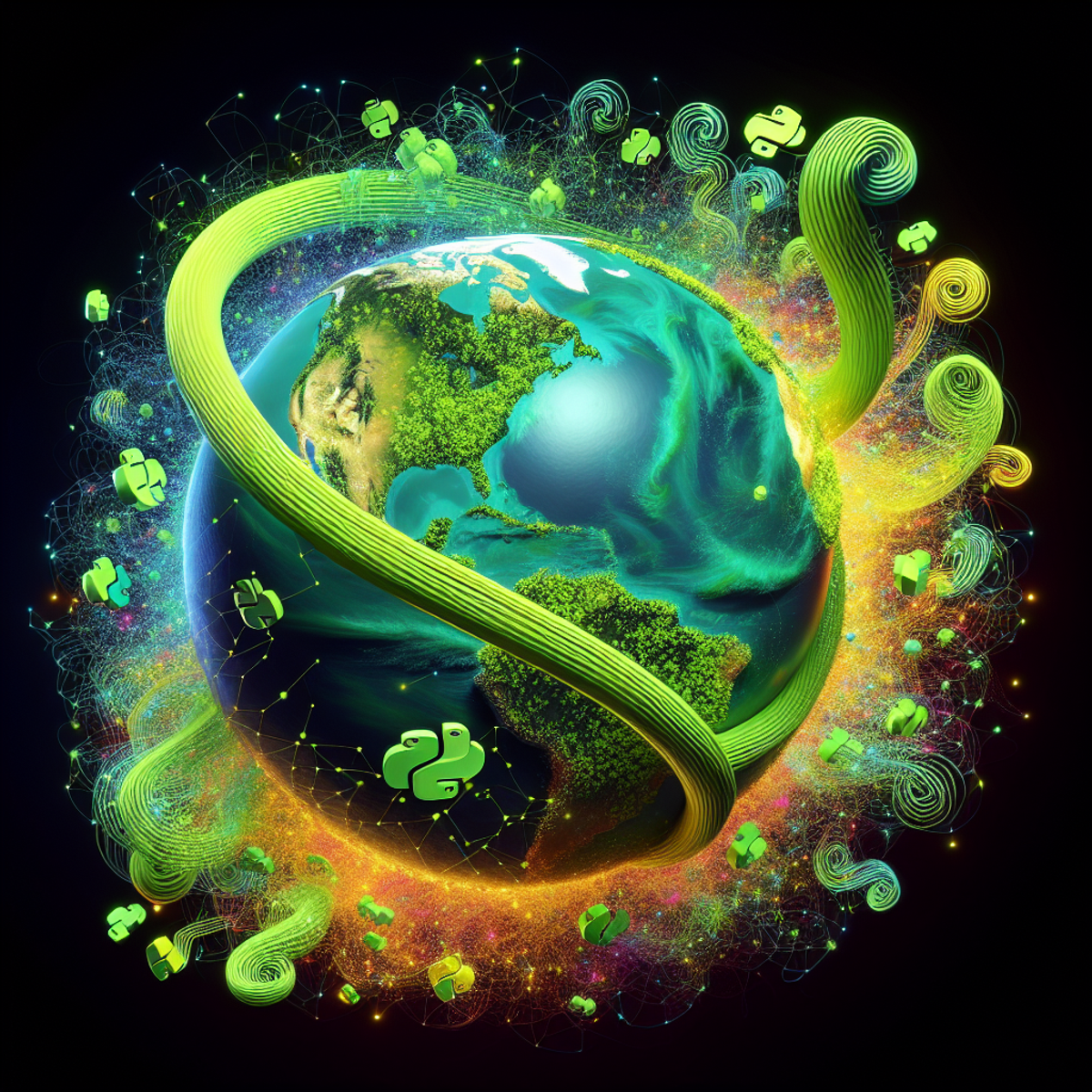Python for Carbon Footprint Analysis

Python for Carbon Footprint Analysis
Introduction
Carbon footprint analysis is an essential process in understanding and reducing the environmental impact of human activities. It helps us measure the amount of greenhouse gas emissions produced directly or indirectly by individuals, organizations, or products. By identifying areas for improvement and developing strategies to lower emissions, we can work towards a more sustainable future.
In this article, we will explore how Python can be used as a powerful tool for carbon footprint analysis. Python is a versatile and widely-used programming language that offers numerous libraries and tools specifically designed for environmental sustainability purposes. Its simplicity, readability, and extensive ecosystem make Python an ideal choice for conducting carbon footprint analysis.
Why Python?
Python stands out as an excellent option for analyzing carbon footprints due to its:
- Versatility: Python can handle various tasks involved in carbon footprint analysis, from data manipulation to statistical calculations.
- Data handling capabilities: With libraries like Pandas, Python simplifies complex data manipulation tasks, making it easier to work with large datasets.
- Statistical analysis power: Libraries such as NumPy and SciPy provide advanced statistical functions needed for comprehensive carbon footprint analysis.
- Automation potential: Python's scripting capabilities allow for the automation of repetitive tasks, saving time and effort in the analysis process.
- Visualization options: Python's visualization libraries, including Matplotlib and Plotly, make it simple to create informative plots and interactive visualizations to communicate results effectively.
Python's role in carbon footprint analysis extends beyond data processing and analysis. In the following sections, we will explore specific tools, libraries, and case studies that demonstrate Python's effectiveness in driving sustainable practices through carbon footprint analysis.
Carbon Footprint Analysis
Carbon footprint analysis is a crucial process in evaluating the environmental impact of various activities, products, or services. It involves measuring the amount of greenhouse gases, particularly carbon dioxide, released into the atmosphere as a result of human activities. This assessment provides valuable insights into the overall environmental sustainability and allows organizations and individuals to identify areas for improvement.
Importance of Carbon Footprint Analysis
Understanding Environmental Impact
Conducting carbon footprint analysis is essential for understanding the impact of human activities on the environment, including the release of greenhouse gases. It helps in identifying sources of emissions and their contributions to climate change.
Sustainability Planning
By analyzing carbon footprints, organizations can develop sustainable strategies to reduce emissions, minimize environmental impact, and work towards achieving carbon neutrality. This can be aided by using tools such as carbon footprint calculators to measure and manage individual or organizational emissions.
Regulatory Compliance
Many jurisdictions have implemented regulations that require businesses to measure and report their carbon emissions. Conducting thorough carbon footprint analysis ensures compliance with these regulations.
Challenges in Carbon Footprint Analysis
Data Collection and Accuracy
Gathering accurate data on energy consumption, transportation, and other activities can be challenging. Ensuring data accuracy is vital for reliable carbon footprint assessments.
Scope and Boundaries
Defining the scope of analysis and setting boundaries for what should be included in the assessment requires careful consideration to avoid under or overestimation of emissions.
Interpreting Results
Interpreting the results of a carbon footprint analysis and identifying actionable measures for emission reduction can be complex and requires expertise in environmental science and sustainable practices.
Role of Python in Carbon Footprint Analysis
Python has emerged as a valuable tool for conducting carbon footprint analysis due to its versatility, extensive libraries, and ease of use. The language's ability to handle large datasets, perform complex calculations, and visualize data makes it well-suited for environmental impact assessments.
With the availability of specialized libraries such as CodeCarbon.io and PyLMDI, Python offers specific solutions tailored to carbon footprint analysis:
- CodeCarbon.io: This library provides capabilities for estimating CO2 emissions from computing resources used for code execution. It not only quantifies emissions but also offers suggestions for emission reduction based on resource usage patterns.
- PyLMDI: PyLMDI simplifies index decomposition analysis related to building carbon emissions. It aids in calculating carbon emission reductions by providing an efficient approach to analyze factors contributing to changes in emissions over time.
By leveraging Python's data processing capabilities along with these dedicated libraries, researchers, analysts, and organizations can streamline their carbon footprint analyses and gain actionable insights for environmental sustainability efforts.
Python for Carbon Footprint Analysis
Python has become a valuable tool for conducting carbon footprint analysis, offering a wide range of capabilities and libraries to support environmental impact assessments. From estimating CO2 emissions to analyzing climate data and examining the environmental impact of machine learning, Python provides a versatile platform for addressing sustainability challenges.
Versatility in Carbon Footprint Analysis
Python's versatility in carbon footprint analysis is evident through its ability to:
- Estimate CO2 Emissions: With libraries such as CodeCarbon.io, Python enables users to estimate CO2 emissions from computing resources, whether in cloud environments or personal devices. This empowers individuals and organizations to assess the environmental impact of their digital activities.
- Offer Emission Reduction Suggestions: CodeCarbon.io goes beyond emission estimation by providing actionable suggestions for reducing emissions. By leveraging Python, users can proactively identify and implement strategies to minimize their carbon footprint.
- Simplify LMDI Calculation: The introduction of PyLMDI simplifies the calculation process for index decomposition analysis of building carbon emissions. This enhances the efficiency of carbon emission reduction efforts in the context of building sustainability.
Climate Data Analysis
In addition to carbon footprint estimation, Python plays a crucial role in climate data analysis. Through libraries like NumPy and Pandas, Python facilitates the processing and analysis of large-scale climate datasets. This capability is essential for understanding climate change impacts and formulating effective mitigation strategies.
Environmental Impact of Machine Learning
As machine learning continues to gain prominence across various industries, there arises a need to assess its environmental implications. Python offers libraries that enable the optimization of machine learning models for reduced energy consumption. This proactive approach aligns with sustainable practices by minimizing the environmental impact of technology-driven processes.
Real-World Applications
Real-world case studies demonstrate the practical application of Python in carbon footprint analysis across diverse sectors. These examples serve as compelling evidence of Python's effectiveness in driving sustainable practices through data-driven insights. Whether it's estimating emissions in cloud computing environments or analyzing carbon emissions from buildings, Python proves to be a versatile ally in environmental impact assessments.
By harnessing Python's capabilities for carbon footprint analysis, individuals and organizations can proactively engage in sustainability efforts, leading to informed decision-making and meaningful contributions to environmental conservation.
1. Tools and Libraries for Carbon Footprint Analysis with Python
Python libraries are essential for efficient carbon footprint analysis. Two notable libraries, CodeCarbon.io and PyLMDI, offer valuable features for estimating CO2 emissions and simplifying complex calculations.
CodeCarbon.io Library: Estimating CO2 Emissions from Code Execution
CodeCarbon.io is a powerful Python library designed to estimate CO2 emissions from computing resources used for code execution. It provides insights into the environmental impact of executing code on various platforms, including personal computers and cloud servers.
Key Features of CodeCarbon.io:
- Detailed metrics on energy consumption and carbon emissions
- Information about the environmental impact of different computing platforms
- Insights to help users make informed decisions about their coding practices
CodeCarbon.io's Emission Reduction Suggestions: Optimizing Code for Sustainability
In addition to estimating emissions, CodeCarbon.io goes a step further by providing practical suggestions for emission reduction. It offers recommendations for optimizing code execution to minimize energy consumption and carbon footprint, contributing to sustainable software development practices.
PyLMDI Tool: Simplifying Carbon Emissions Analysis with LMDI Calculation
PyLMDI is an innovative Python tool that simplifies the calculation process for Logarithmic Mean Divisia Index (LMDI) in building carbon emissions analysis. It streamlines the complex LMDI calculation, making it more accessible for researchers and analysts working on carbon footprint reduction initiatives.
Key Features of PyLMDI:
- Streamlined calculation process for Logarithmic Mean Divisia Index (LMDI)
- User-friendly interface for researchers and analysts
- Applicable in carbon emissions analysis for buildings
PyLMDI's Contribution to Carbon Emission Reduction in Buildings: Identifying Key Drivers of Emissions
PyLMDI plays a vital role in analyzing and quantifying the factors contributing to carbon emissions from buildings. By facilitating LMDI calculations, it enables stakeholders to identify key drivers of carbon emissions and devise targeted strategies for emission reduction in building operations.
By leveraging these Python libraries, professionals engaged in carbon footprint analysis can gain valuable insights into emissions estimation, reduction strategies, and complex calculations related to building carbon emissions. The seamless integration of these tools empowers users to make data-driven decisions towards environmental sustainability.
2. Using Python for Climate Data Analysis
Climate data analysis is essential for understanding and addressing the effects of climate change. Python provides a powerful platform for researchers and scientists to analyze large datasets, perform complex calculations, and visualize data for valuable insights. With a wide range of libraries and tools available, Python makes climate data analysis more accessible and efficient. Let's take a look at some popular Python libraries used in this field:
NumPy: Efficient Numerical Computing
NumPy is a fundamental library for scientific computing in Python. It offers support for working with large arrays and matrices, along with a collection of mathematical functions to operate on these arrays efficiently. Here are some key features of NumPy that are relevant to climate data analysis:
- Fast array operations: NumPy allows for efficient computation with large arrays, which is particularly useful when working with extensive climate datasets.
- Broadcasting: This feature enables performing operations on arrays with different shapes, simplifying tasks like adding or multiplying arrays with different dimensions.
- Linear algebra: NumPy provides functions for common linear algebra operations such as matrix multiplication, eigenvalue decomposition, and singular value decomposition.
Pandas: Data Manipulation and Analysis
Pandas is a powerful library built on top of NumPy that facilitates data manipulation and analysis. It provides easy-to-use data structures such as DataFrame, which is particularly useful for working with tabular data commonly encountered in climate research. Here are some key features of Pandas:
- Data alignment: Pandas automatically aligns data based on labels, making it easy to combine and manipulate datasets.
- Data cleaning: The library offers various functions to handle missing values, outlier detection, and filtering based on specific criteria.
- Time series analysis: Pandas provides functionality to handle time series data efficiently, enabling researchers to analyze climate patterns over time easily.
- Data visualization: Pandas integrates well with other visualization libraries like Matplotlib and Seaborn, allowing for the creation of insightful plots and charts.
These libraries, along with others like Matplotlib, Seaborn, and SciPy (which is covered in detail here), form a robust ecosystem for climate data analysis in Python. Researchers can leverage these tools to explore, model, and interpret climate data effectively. Here are some ways in which Python is used in climate data analysis:
- Data preprocessing: Python libraries make it easier to clean and preprocess large climate datasets by handling missing values, removing outliers, and transforming data into suitable formats.
- Statistical analysis: Python provides powerful statistical functions that enable researchers to analyze climate data, perform hypothesis testing, and derive meaningful insights.
- Data visualization: With the help of libraries like Matplotlib and Seaborn, Python allows researchers to create visually appealing plots, charts, and maps that aid in understanding and communicating climate patterns and trends.
- Machine learning: Python's machine learning libraries such as scikit-learn can be used to develop predictive models based on climate data. These models can help researchers forecast future climate scenarios and assess potential impacts.
In summary, Python offers a versatile set of libraries and tools for climate data analysis. From preprocessing and statistical analysis to data visualization
3. Examining the Environmental Impact of Machine Learning with Python
Machine learning is widely used in different industries to improve processes and decision-making. However, it's important to think about how this technology can affect the environment. Python has many tools and libraries that can help us make machine learning models more efficient, reducing their energy usage and environmental impact.
The Growing Role of Machine Learning and its Environmental Implications
Machine learning algorithms have proven to be very effective in tasks like identifying images, understanding language, and making predictions. Because of this, they are being used more and more in industries such as transportation, healthcare, finance, and agriculture. However, these algorithms require a lot of computational power, which means they also use up a lot of energy and produce carbon emissions.
To make sure we're using technology in a sustainable way, we need to look at the environmental impact of machine learning. By understanding the potential problems it can cause and finding ways to solve them, we can make smart choices that balance our need for technology with our responsibility to protect the environment.
Python Libraries for Optimizing Machine Learning Models
Python has some great libraries that can help us make our machine learning models more efficient. These libraries provide techniques for compressing models, training them more quickly, and making predictions faster. Here are a few examples:
- TensorFlow: TensorFlow is a popular open-source library that's often used for deep learning. It has tools for optimizing models using methods like quantization, which reduces the amount of memory they need without hurting their performance too much. This can help us save energy when running our models.
- PyTorch: PyTorch is another deep learning library that's similar to TensorFlow. It also has ways to optimize models by using less energy. For example, we can use techniques like knowledge distillation or network pruning to create smaller models that still work well.
- Scikit-learn: Scikit-learn is a comprehensive library for machine learning that has lots of different algorithms and tools. It includes features for picking out the most important parts of our data and reducing its complexity. This can make our models faster and more energy-efficient.
Balancing Performance and Energy Efficiency
When we're trying to make our machine learning models more energy-efficient, it's important to find a good balance between performance and resource usage. While saving energy is crucial, we also want our models to be accurate and useful. Here are some strategies that can help us achieve this balance:
- Model Quantization: By using lower-precision numbers to represent the weights and values in our models, we can reduce their memory usage and make them faster to run. This trade-off usually doesn't hurt their performance too much.
- Knowledge Distillation: This technique involves training a smaller model to imitate the behavior of a larger model. The smaller model can be simpler and use less energy while still giving us good results.
- Network Pruning: Network pruning is a method for making neural networks smaller and faster by removing unnecessary parts. We can get rid of connections or filters that don't contribute much to the model's accuracy.
By using these techniques in Python, we can make our machine learning models more energy-efficient without losing too much performance.
As machine learning continues to be important in many industries, we need to think about how it affects the environment. Python has powerful libraries that let us optimize our machine learning models so they use less energy. By using techniques like model quantization, knowledge distillation, and network pruning, we can find a balance between performance and being environmentally friendly. With these efforts, we can benefit from machine learning while also reducing its impact on the planet.
4. Case Studies: Applying Python in Real-World Carbon Footprint Analysis Projects
To demonstrate the effectiveness of Python in carbon footprint analysis, it's important to showcase real-world examples where Python has been successfully applied. These case studies highlight the versatility of Python and its ability to tackle carbon footprint analysis across different sectors. Let's explore a couple of these case studies:
Case Study 1: Estimating Emissions in Cloud Computing Environments
One notable application of Python in carbon footprint analysis is the use of Python along with the CodeCarbon.io library to estimate emissions in cloud computing environments. Cloud computing has become increasingly popular due to its scalability and cost-effectiveness. However, it is essential to assess the environmental impact of this technology.
CodeCarbon.io provides a Python API that allows users to estimate CO2 emissions from their cloud or personal computing resources used for code execution. By integrating CodeCarbon.io into their workflow, users can track and analyze the carbon emissions associated with their cloud-based applications. This information can then be used to optimize resource allocation and make informed decisions regarding energy consumption.
Case Study 2: Analyzing Carbon Emissions from Buildings
Another practical application of Python in carbon footprint analysis involves analyzing carbon emissions from buildings. In this case, the PyLMDI tool proves to be a valuable asset. PyLMDI simplifies the LMDI calculation for index decomposition analysis of building carbon emissions.
By using PyLMDI, analysts can efficiently calculate and evaluate various factors contributing to carbon emissions in buildings, such as energy consumption, occupancy patterns, and heating/cooling systems. This information allows stakeholders to identify areas for improvement and implement targeted strategies for reducing carbon emissions in buildings.
Additional Case Studies Demonstrating Python's Versatility
Apart from these specific examples, there are numerous case studies that highlight Python's versatility in carbon footprint analysis across different sectors:
- Transportation Sector: Python has been used to analyze transportation data and estimate carbon emissions from vehicles. By leveraging Python libraries for data analysis and visualization, analysts can gain insights into emissions patterns, fuel efficiency, and the environmental impact of different transportation modes.
- Manufacturing Sector: Python can also be applied to analyze manufacturing processes and assess their carbon footprint. By collecting data on energy consumption, waste generation, and raw material usage, Python can help identify opportunities for process optimization and emission reduction.
- Renewable Energy Sector: Python can aid in the analysis of renewable energy systems and their impact on carbon emissions. By modeling and simulating different scenarios using Python libraries such as Pandas and NumPy, analysts can optimize the deployment of renewable energy resources and quantify their contribution to reducing carbon emissions.
These real-world case studies demonstrate that Python is a powerful tool for carbon footprint analysis across various domains. Its versatility, coupled with the availability of specialized libraries and tools, makes it an ideal choice for professionals seeking to drive sustainable practices through effective carbon footprint analysis. Additionally, this paper provides further insights into the use of Python in carbon footprint analysis projects.". Links: "["
Conclusion
Python has become an important tool for conducting effective carbon footprint analysis and promoting sustainable practices. Its flexibility and extensive collection of tools and libraries allow researchers and professionals to gain valuable insights into carbon emissions and make informed decisions to reduce their environmental impact.
Here are the main points to remember from this article:
- Advantages of Python: Python offers many benefits for carbon footprint analysis due to its user-friendly nature, wide range of libraries, and ability to handle large amounts of data. It enables efficient processing, analysis, and visualization of information, making it well-suited for working with the complex datasets involved in carbon footprint analysis.
- Specialized Tools and Libraries: Python's capabilities for carbon footprint analysis are further enhanced by specialized tools and libraries. CodeCarbon.io is a powerful library that estimates CO2 emissions from computing resources and provides suggestions for reducing emissions. PyLMDI simplifies the calculation of carbon emissions from buildings, aiding in the analysis and reduction of emissions in the construction industry.
- Python's Role in Climate Data Analysis: Python is widely used in climate data analysis, playing a crucial role in understanding and addressing the impacts of climate change. Libraries like NumPy and Pandas offer essential features for manipulating, analyzing, and visualizing climate data. These tools enable researchers to identify trends, patterns, and connections that are vital for developing effective strategies to address climate change.
- Considering the Environmental Impact of Machine Learning: As machine learning becomes more prevalent across various sectors, it is important to consider its environmental consequences. Python libraries such as TensorFlow and PyTorch provide features that optimize machine learning models for lower energy consumption. By utilizing these tools, developers can create models that are both energy-efficient and high-performing.
- Real-World Examples: Real-world case studies demonstrate how Python can be effectively used in carbon footprint analysis across different industries. For instance, combining Python with CodeCarbon.io can estimate emissions in cloud computing environments, assisting organizations in making informed decisions about their computing resources. PyLMDI facilitates the examination of carbon emissions in buildings, enabling the identification of areas for improvement and strategies to reduce emissions.
Python is a powerful tool for carbon footprint analysis, supporting sustainability efforts in various fields. Its extensive range of tools and libraries, combined with its user-friendly nature, make it accessible to both researchers and professionals. By harnessing the capabilities of Python and utilizing its ecosystem, individuals and organizations can actively promote sustainable practices and contribute to a greener future.
Python is not just a programming language; it is an enabler for positive change towards a sustainable world.
FAQs (Frequently Asked Questions)
What is the significance of Python in carbon footprint analysis?
Python is a valuable tool for carbon footprint analysis due to its versatility and extensive libraries that can be utilized for environmental sustainability purposes.
What are some tools and libraries available for carbon footprint analysis with Python?
Some tools and libraries for carbon footprint analysis with Python include CodeCarbon.io, PyLMDI, and others that aid in estimating CO2 emissions from computing resources and simplifying LMDI calculation in building carbon emissions analysis.
How can Python be used for climate data analysis?
Python can be used for climate data analysis through libraries such as NumPy and Pandas, which are essential for understanding and mitigating climate change impacts.
What is the potential environmental impact of machine learning, and how can Python help mitigate it?
Machine learning has potential environmental implications due to energy consumption. Python offers libraries that help optimize machine learning models for reduced energy consumption, thus mitigating its environmental impact.
Can you provide examples of real-world projects where Python has been applied in carbon footprint analysis?
Real-world examples include the use of Python and CodeCarbon.io for estimating emissions in cloud computing environments, as well as the application of PyLMDI in analyzing carbon emissions from buildings. These examples showcase Python's versatility in carbon footprint analysis across different sectors.
What is the role of Python in driving sustainable practices through effective carbon footprint analysis?
Python plays a crucial role in driving sustainable practices by providing powerful tools and libraries for effective carbon footprint analysis, thereby contributing to environmental sustainability.
Comments
Post a Comment